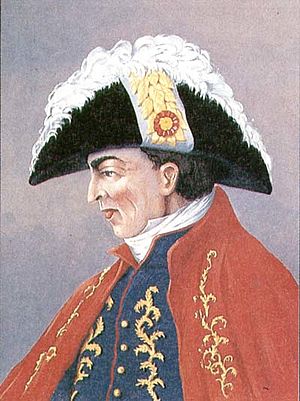Juan de Sámano facts for kids
Juan José Francisco de Sámano y Uribarri (born in 1753 in Selaya, Cantabria, Spain – died in July 1821 in Panama) was a Spanish military officer. He served as the viceroy of New Granada from 1818 to 1819. This was a time when New Granada was fighting for its independence from Spain.
Contents
Early Military Life
Sámano came from an important family with a long history in the military. He joined the army as a cadet in 1771. By 1779, he had become a lieutenant. He also taught mathematics at the Military Academy in Barcelona, Spain, for five years.
In 1780, he moved to the Americas, which were then called the Indies. He first went to Puerto Rico, then to Cuba, and finally to Cartagena de Indias in what is now Colombia. He returned to Europe in 1785. In 1789, he was promoted to captain. He fought in a war against revolutionary France, where he was wounded in both legs.
Fighting for Spain in New Granada
In 1794, Sámano asked to be transferred back to New Granada. He became the governor of Riohacha in 1806. There, he successfully defended the city from a British attack. From Riohacha, he traveled to Bogotá with 30 cavalry soldiers. He offered to help the viceroy, Antonio José Amar y Borbón, fight against the people who wanted independence.
As a colonel, Sámano was in charge of a special battalion in Bogotá. This was during the "Florero de Llorente" (Cry of Independence) on July 20, 1810. Many of his officers secretly supported the revolution. Sámano was relieved of his command the next day. He was given a passport to leave New Granada.
Battles and Leadership
Sámano returned to Spain. He was then sent back to the Americas to help bring peace to Quito and Guayaquil. From Quito, he led military actions against the rebels in New Granada. In 1813, he was chosen to lead an expedition to take back the southern part of the Viceroyalty of New Granada. He reached the city of Popayán on July 1, 1813. There, he announced that the Constitution of Cádiz (a new Spanish law) was in effect. He was promoted to brigadier.
However, Sámano was defeated by Antonio Nariño in the Battle of Alto Palacé in December 1813. He was defeated again in the Battle of Calibío in January 1814. He fled with a small group of soldiers to Pasto. Another general, Melchor Aymerich, replaced him. This was because, even though Sámano was loyal, more daring tactics were needed.
Sámano went back to Quito. He was given command of another expedition to New Granada. His command in Pasto was given back to him. On June 29, 1816, he won a major victory at Cuchilla del Tambo. He defeated the rebel leader Liborio Mejía. Many rebels were killed or captured, and Sámano's forces took all their weapons.
On July 1, 1816, Sámano's troops took Popayán again. Among the captured rebels was José Hilario López, who later became president of New Granada. Sámano ordered the execution of another rebel leader, Carlos Montúfar.
After this, Sámano was promoted to field marshal. He was put in charge of Bogotá as the commanding general of New Granada. He arrived in Bogotá on October 23, 1816. He started a strict program to punish rebels. He set up special courts to judge those involved in the rebellion. Some of the rebel leaders who were executed included Camilo Torres, Francisco José de Caldas, and Policarpa Salavarrieta.
Becoming Viceroy
In August 1817, Sámano was named viceroy, governor, and captain general of New Granada. He also became the president of the Audiencia (a high court) of Bogotá. He was given a special award, the Grand Cross of the Order of San Hermenegildo, for his service to the Spanish Crown. He officially took his new positions on March 9, 1818. He also helped establish the Academy of Medicine in Bogotá. However, the Audiencia later complained about his leadership to Spain.
On August 9, 1819, news arrived that the Spanish forces had been defeated in the Battle of Boyacá. Sámano quickly fled to Cartagena de Indias. However, the people there did not accept his authority because of his reputation for harsh actions.
He sailed to Jamaica but soon returned to Panama. He stayed there without any official power until he resigned. In August 1819, being old and unwell, he stepped down as viceroy. He remained in Panama until his death in July 1821, waiting for permission to return to Spain.
See also
 In Spanish: Juan de Sámano para niños
In Spanish: Juan de Sámano para niños


